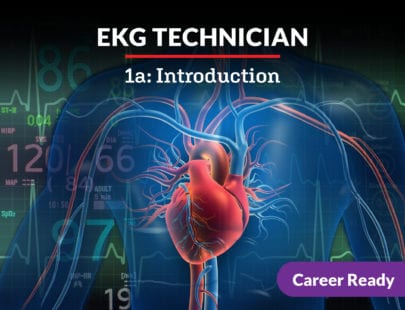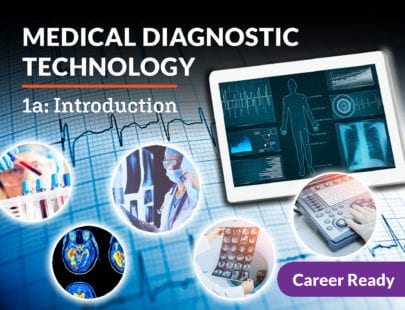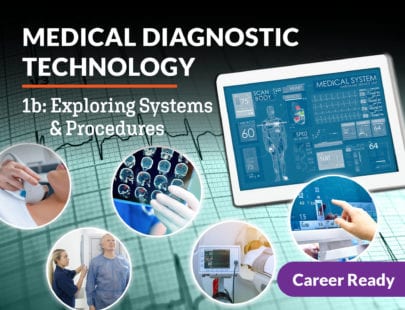
EKG Technician 1b: Analysis and Response
Does the thought of becoming an EKG Technician still make your heart skip a beat? Continue your journey through the peaks and valleys of EKG waves and really dig into the details of the cardiac code to fulfill your ultimate goal: saving lives! This course will prepare you to interpret different EKG waves, how to spot wave abnormalities, how to differentiate between different disorders, and how to treat those disorders. Let’s get ready to continue your adventure into the world of cardiology and a possible career as a EKG Technician!
Units at a Glance
Unit 1: Patient Care Considerations
The little things we do when caring for patients make all the difference in how well a test or a procedure goes. As we explore patient care considerations, we’ll look at the things we do and say before, during, and after a procedure as part of care delivery. We’ll investigate ways to keep the patient safe, the best ways to communicate, and the steps to take throughout the testing process. Together, we’ll find the best ways to make our patients our priority!
What will you learn in this unit?
- Describe universal precautions and the personal protective equipment used to keep healthcare providers and patients safe.
- Explain the proper ways to transfer and transport patients
- Analyze vital signs in order to assess for abnormalities and provide first aid and emergency response, if needed
- Identify the ways to prepare patients mentally and physically for a procedure
- Name the steps of the pre-EKG process along with precautions and safety measures
Unit 2: What’s in a Wave? The EKG Strip
Armed with the knowledge of how to provide the best patient care, we’re getting closer to using our skills as EKG techs. Before performing EKGs on patients, we need to understand exactly what we’re recording and what that wave really means. During our exploration of what seems to be a tiny wave on graph paper, we’ll see how the information contained in that wave is a lot more than meets the eye. Let’s break down each part of an EKG strip and find out what’s in a wave!
What will you learn in this unit?
- Describe the parts of the PQRST wave, including measurements for each part
- Discuss ways to calculate the heart rate
- Define the electrical axis and describe its relationship to the EKG leads
- Explain the purpose of pacemakers and identify pacemaker spikes on the EKG strip
- Analyze EKG artifacts and take steps to correct them
Unit 3: Normal and Sinus Rhythms
To determine what’s abnormal in an EKG, we first need to understand what’s normal. As we decipher the characteristic PQRST wave, we’ll see what sinus rhythm is and break down variations of this type of waveform, including the impact on patients and the proper response by healthcare professionals. So, is a sinus rhythm good or bad for the patient? In this quest, we’ll dissect the parts of the EKG wave to find the answer!
What will you learn in this unit?
- Describe and recognize normal sinus rhythm
- Explain sinus tachycardia
- Identify sinus bradycardia
- Interpret sinus arrhythmia
- Elucidate sinus pause, sinus arrest, and junctional escape beats
Unit 4: When It’s Not Sinus: Arrhythmias
Just like any complex system, the electrical conduction system of the heart doesn’t always function as it should. During this learning adventure, we’ll investigate various types of arrhythmias and learn how to recognize them. As you might guess, an EKG tech plays a key role in initiating quick responses to some of them! Do you want to learn more about the part you’ll play as a member of a healthcare team? Let’s find out what happens when it’s not sinus rhythm but an arrhythmia!
What will you learn in this unit?
- Identify and respond to atrial, ventricular, and junctional arrhythmias
- Differentiate between normal sinus rhythm and dysrhythmias and report them appropriately
- Define the cardiac alarm policy and its importance at any healthcare facility
Unit 5: Changes in the Strip: Abnormalities
With so many possible conditions impacting the way the heart functions, we need a way to help identify what’s really going on. During this part of our EKG investigation, we’ll look at various abnormalities to examine their causes and their appearance on the strip. As we’ll see, recognizing these changes is the key to a healthcare worker’s response to and report of irregular findings. It’s time to learn how to decode the meaning of changes in the strip!
What will you learn in this unit?
- Explain the physiology behind bundle branch blocks and identify them on an EKG
- Differentiate between first- and second-degree heart blocks and recognize them on the EKG
- Describe third-degree heart blocks and recognize them on the EKG
- Define chamber enlargement and hypertrophy and recognize them on the EKG
- Distinguish between normal and abnormal EKG findings for pacemakers or implantable cardioverter defibrillators
Unit 6: Identifying Ischemia, Injury, and Infarction
Before we began our in-depth study of cardiac arrhythmias and abnormalities, the first condition that probably would have come to mind if you were asked about the heart would have been a heart attack. Although that answer isn’t wrong, as we’ve seen, we need to know much more to diagnose a patient. As we continue our study, we’ll see that not all chest pain means that the patient is having or has had a heart attack! In fact, this condition can be further divided into what type of damage has occurred and how the EKG demonstrates this damage. Let’s learn about cardiopulmonary compromise, myocardial ischemia, injury, and infarction to get a better idea of how to decipher the EKG for each type of patient!
What will you learn in this unit?
- Recognize cardiopulmonary compromise by its signs, symptoms, and the EKG to respond appropriately
- Analyze signs, symptoms, and EKG changes to identify myocardial ischemia, injury, and ST elevated myocardial infarction
- Identify non-ST elevated myocardial ischemia and other ischemias
- Describe the qualities of effective leaders and team members as well as the roles they play in improving the healthcare environment
Unit 7: The Effects of Drugs and Other Chemicals
Medications provide a way to improve patient conditions, but sometimes, the “cure” is worse than the original problem. To gain a clearer understanding of how drugs and other chemicals affect patients and their heart rhythms, we need to perform a more in-depth investigation. As we take a closer look, we’ll see how these chemicals work to change body function, we’ll examine any adverse reactions, and we’ll learn how each changes an EKG strip. Let’s discover the good, the bad, and the side effects of chemicals within the body!
What will you learn in this unit?
- Describe common cardiovascular drugs inside and outside of Classes I–IV, including their mechanism of action and adverse effects
- Identify EKG changes related to cardiovascular drugs and distinguish normal changes from abnormal ones
- Understand electrolyte imbalances and their effects on the EKG
- Explain how the EKG tech uses critical thinking and problem solving to identify the causes of the patient’s problem and possible solutions
Unit 8: Take a Closer Look: Other Cardiovascular Modalities
As we’ve seen, the EKG allows healthcare professionals to take a closer look at how well the heart’s electrical system is working. Sometimes, the results lead to answers, while in other cases, more questions arise. To help answer those questions, providers use a variety of other types of cardiovascular testing and procedures. As we explore these other options, we’ll examine their benefits and risks as well as the reasons one choice is better than another. Let’s take a closer look!
What will you learn in this unit?
- Describe noninvasive cardiovascular modalities like the cardiovascular reflex test, CT, and MRI
- Explain the types of cardiovascular ultrasounds
- Differentiate between radiographic cardiovascular imaging and nuclear cardiovascular imaging
- Outline invasive diagnostic and interventional cardiovascular procedures
- Identify surgical cardiovascular treatments and developments in treatment options
Required Materials
Physical
- Video recording device
- Audio recording device
- Couch, bed, low table, or similar object a human can lie flat on safely
- Mannequin, scene partner, large doll, or stuffed animal
- Chair
Software
- Word processing software
- Slide presentation software
- Image editing software
Optional
- Graph paper and writing utensil
- Camera
- Scanner
- Spreadsheet software
- Markers and paper


